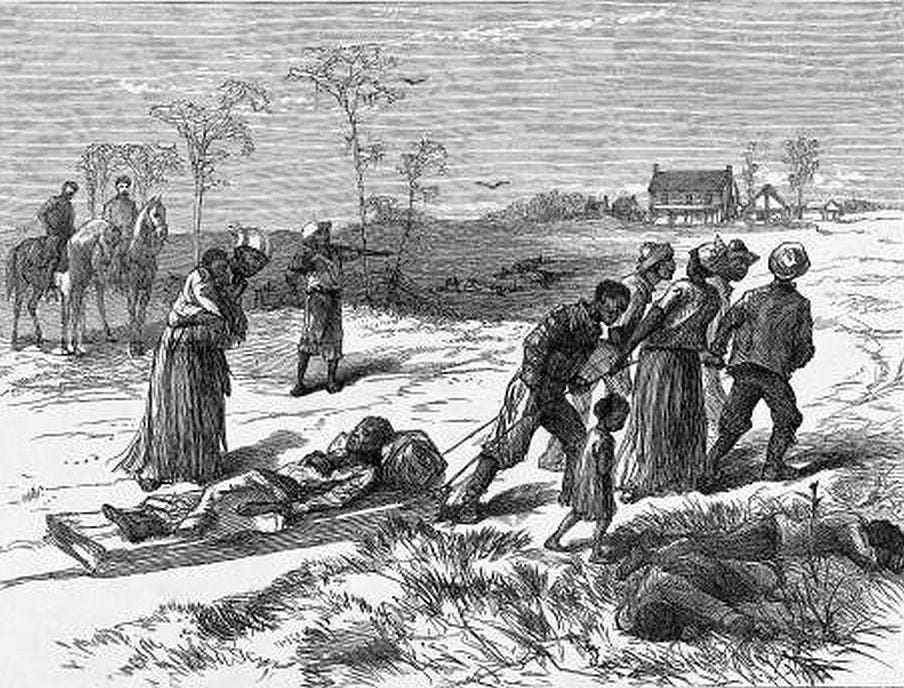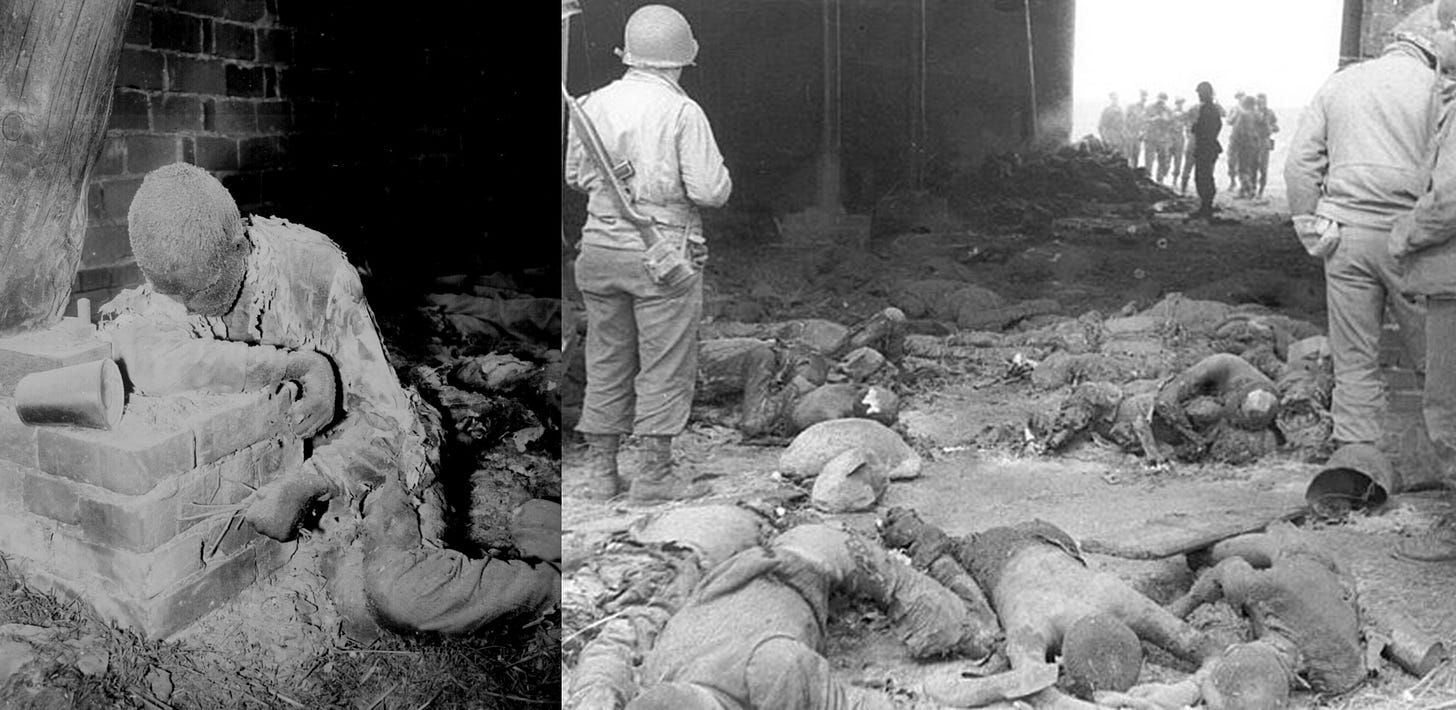The Mysteries of History (April 13 Edition)
Hailstorm Kills 1,000 Soldiers; Colfax Massacre; Amritsar Massacre; Gardelegen Barn Massacre
“Those who cannot remember the past are condemned to repeat it.” — Spanish-American philosopher George Santayana, 1905
“He is free to evade reality, he is free to unfocus his mind and stumble blindly down any road he pleases, but not free to avoid the abyss he refuses to see.” — Alice O’Connor, 1961
1360 — 1,000 Killed By Hailstones
image generated using Bing Image Creator
During the Hundred Years’ War between England and France (1337-1453, with at least one break of a few years between), a large group of British soldiers were pummeled by a sudden hailstorm that struck near the town of Chartres, France on this day in 1360.
With no shelter available to them, an estimated 1,000 British soldiers died from the hellacious downpour. This put a temporary end to England’s desire to take over France, although England was given a part of northern France as a concession.
Questions: What was the end result of the Hundred Years’ War (who, if anybody, benefited from it; how did it change the lives of those who lived in Europe, especially Britain and France)? How many British soldiers died? How many French soldiers died? How many civilians died? Did France and England fight any wars against each other previous or subsequent to this?
1873 — Colfax Massacre
public domain image from wikimedia commons
April 13th is a day for massacres in history: 1873 in Colfax, Louisiana; 1919 in Amritsar, India; and 1945 in Gardelegen, Germany. Depending on your understanding of the definition of the world “massacre,” it could also be said that the bombing of tunnels in Afghanistan in 2017 using “The Mother of All Bombs,” which resulted in the deaths of over 90 Islamic State militants, was also a massacre — at least in the same sense that you would say something like, “The Orioles massacred the Yankees today, 13-0.”
As for that first massacre: In Colfax, Louisiana, on this date in 1873, a mob attacked a courthouse where a militia comprised primarily of black men were stationed. A gunfight ensued, but when the White Supremacist mob aimed a cannon at the courthouse, the militia surrendered. The mob then engaged in a day-long slaughter of those, killing three white men and around 150 black people (the massacre extended to residents of the town also, in what became known as The Colfax Massacre.
This incident was one example of how Reconstruction gradually unraveled. The Civil War was meant to put an end, not only to slavery, but also racial inequality, but it didn’t work out that way. Righteousness cannot be legislated. Human kindness, love, and respect cannot be mandated. By the 1870s, Reconstruction was on its death bed, and by 1880, it had proven to be a failure. Literal slavery was gone, but racism, hatred, and a form of slavery called sharecropping and tenant farming took its place.
Questions: Why did Reconstruction fail? Who or what was “Jim Crow”? What do you think Lincoln would have done had be still been living when Reconstruction gradually unraveled? Who was or were U.S. President(s) during this time period?
1919 — Amritsar (Jallianwala Bagh) Massacre
public domain images from wikimedia commons
On this date in 1919, shortly after World War 1 ended, at least 379 East Indians were massacred in the city of Amritsar by British and Gurkha (East Indian national) troops led by British Brigadier General Reginald Dyer (1864-1927). The slaughtered were peacefully protesting against British conscription (military draft) and heavy taxes (taxation without meaningful representation, anyone?).
Besides the at least 379 men, women, and children killed, thousands were injured when the troops surrounded them and then, without warning, opened fire on the startled crowd. This heartless mass execution is known as both the Amritsar Massacre and the Jallianwala Bagh Massacre.
When later asked to explain his thought process and motive for the attack, Dyer stated that he ordered the attack for its “moral effect” on the populace. In other words, he “burned the village in order to save it.”
Who can read of this and not think of the American Revolution (taxation without representation) and the protests that occurred during the Vietnam War (Kent State, “Four Dead in O-hi-o”)? History does at least echo itself, far too often, because people don’t meditate on Santayana’s famous words (quoted at the top).
Mohandas “Mahatma” Gandhi (1869-1948) had previously supported the British in an appeasing sort of way, but this event “radicalized” him, in that he would no longer be satisfied with just a modified independence from Britain for India. He began his program of inciting mass civil disobedience. And, of course, soon after India gained its independence in 1947, Gandhi was assassinated by a John Wilkes Booth-like whiner.
Questions: Did Dyer ever accept responsibility for his actions? That is to say, did he come to the realization that he was wrong to massacre hundreds of people?
1945 — Nazis Burn 1,000 Trapped in a Barn
public domain images from wikimedia commons
It was not hardened soldiers that burned 1,000 people alive in a barn in Gardelegen, Germany, on this date in 1945, but members of the Hitler Youth and local police.
Those killed were herded into a barn, which was then set aflame. The “fish in a barrel” inside the barn who tried to escape were shot dead as they emerged, or partially emerged, from the structure.
American troops arrived when the Germans were trying to “get rid of the evidence” of their diabolical behavior by completely incinerating the bodies. An American G.I. on the scene had this to say about the effect what he witnessed there had on him: “I never was so sure before of exactly what I was fighting for. Before this you would have said those stories were propaganda, but now you know they weren't. There are the bodies and all those guys are dead.”
Questions: Were any of those responsible for this outrage ever called to account for it? How much longer did the war last?
Read about “The Secret Lives of Kids” here.










